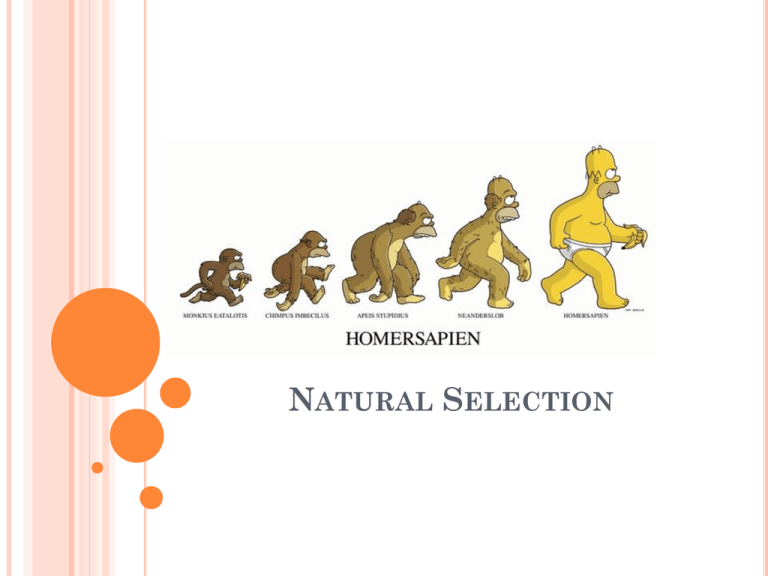Natural Selection
advertisement

NATURAL SELECTION THE THEORY OF EVOLUTION EVOLUTIONARY IDEAS Although Darwin is given much credit for evolutionary theory, he was not the first person to come up with the idea. Evolution is the change in a population over time. The concept of evolution had been discussed for more than 100 years prior to Darwin’s theory. Evolution is the central theme in all fields of biology. CAROLUS LINNAEUS Botanist (1700s) Developed a classification system for all known organisms (at the time). Organisms are together based on their similarities. Groupings in his classification system reflects evolutionary relationships. GEORGES LECLERC DE BUFFON French (1700s) Proposed that species shared ancestors instead of arising separately. Proposed that the Earth was much older than 6000 years (the accepted belief at the time). ERASMUS DARWIN Charles Darwin’s grandfather – 1731 Respected English doctor and a poet. Proposed that all living things were descended from a common ancestor, and that more complex forms of life arose from less-complex forms. JEAN-BAPTISTE LAMARCK French Naturalist (1809) Stated that all organisms evolve toward perfection and complexity. He did not think that species became extinct, only evolved into different forms. THE INHERITANCE OF ACQUIRED CHARACTERISTICS Lamark proposed that changes in an organism’s environment caused an organism’s behavior to change, leading to greater use or disuse of a structure or organ. This structure would become larger or smaller as a result, and these changes would be passed onto the organism’s offspring. This theory is ultimately WRONG. GEOLOGIC CHANGE • The age of the Earth was a key issue in the early debates over evolution. The common view was that the Earth was 6000 years old. – Many scientists argued that the world had to be older based on geologic changes (strata), and the fossils found within them. – • • KT boundary marks the end of the Mesozoic Era and the beginning of the Cenozoic Era. They discovered that certain fossils could be found in different strata, and that fossils near the bottom of a rock formation differ dramatically from those at the top. They developed several theories to explain their findings. CATASTROPHISM The theory that natural disasters, such as floods and volcanic eruptions have happened often during Earth’s history. These events shaped landforms and caused species to become extinct in the process. GRADUALISM The theory that landforms resulted from slow changes over long periods of time. The laying down of soil or the creation of canyons by rivers cutting through rock were not the result of large-scale events, but rather resulted from slow processes that had happened in the past. UNIFORMITARIANISM This theory states that the geologic processes that shape Earth are uniform through time. It proposes that both catastrophy AND small changes (i.e. wind, rain, current, etc) shaped the Earth. It also stated that such changes have occurred at a constant rate and are ongoing. DARWIN CHARLES DARWIN • Was supposed to follow in the family footsteps and become a doctor. – • Found lectures dull and surgery disgusting, so he learned taxidermy, natural history, and geology. In 1831, he took off on the HMS Beagle, and would explore the world (including the Galapagos Islands) for 5 years. – He collected numerous species and took meticulous notes. He would then send them to experts for analysis. VARIATIONS Variation is the difference in the physical traits of an individual from those of other individuals in the group to which it belongs. Interspecific variation Occurs among members of different species. Intraspecific variation Occurs among individuals of the same species. ISLAND VARIATIONS Darwin noted that the species found on one island looked different from those on nearby islands. Many of the islands species looked different from those on the nearest mainland. Ex. Areas with large, hardshelled nuts, often had finches with strong, thick beaks. Conversely, areas with many insects and fruits, had finches with more delicate beaks. ADAPTATION Darwin realized that species must be able to adapt to their environment, and that those adaptations could lead to a genetic change in a population over time. An adaptation is a feature that allows an organism to better survive in its environment. FOSSIL EVIDENCE Darwin also found fossil evidence of species changing over time. Ex. He found the fossils of Glyptodon, a giant armadillo. He hypothesized that it was related, in some way, to the modern armadillo. This suggested that the Earth had to be more than 6000 years old. THE OLDEST LIVING TORTOISE Darwin collected three Galapagos tortoises from the islands, and brought them home. He named them Tom, Dick, and Harry, thinking that all were male. Poorly adapted to the English weather, the tortoises were moved to Australia around 1840. In 1960, scientists realized that Harry (the last surviving tortoise) was really Harriet. In 1992, DNA testing confirmed that Harriet was born in 1830. Today, Harriet lives at the Australia Zoo outside of Brisbane. KEY INSIGHTS Darwin spent more than 20 years compiling evidence to help him form his theory of evolution. He received A LOT of help from fellow scientists, as well as the farmers and breeders of England. ARTIFICIAL SELECTION Artificial selection is the process by which humans change a species by breeding it for certain traits. Humans determine which trait is favorable and then breed individuals that show those traits. Darwin began to breed pigeons to understand artificial selection. ARTIFICIAL SELECTION Darwin compared what he learned from breeding pigeons to his ideas on adaptation. In artificial selection, features such as reversed neck feathers, large crops, or extra tail feathers are selected over generations because breeders like these particular traits. If a feature is not desirable, or “useful”, it would be selected against. NATURAL SELECTION Natural selection is a mechanism by which individuals that have inherited beneficial adaptations produce more offspring on average than do other individuals. In nature, the environment is the selective agent. Therefore, characteristics are selected only if they give advantages to individuals in the environment. STRUGGLE FOR SURVIVAL An English economist, Thomas Malthus, had proposed that resources such as food, water, and shelter were natural limits to population growth. Darwin reasoned that this struggle took place in nature, resources were limited, and organisms had more offspring than could ever survive. Those individuals best suited to their environment would survive and breed. EVIDENCE FOR NATURAL SELECTION NATURAL SELECTION AGAIN There are four main principles to the theory of natural selection: Variation Overproduction Adaptation Descent with Modification VARIATION The heritable differences, or variations, that exist in every population are the basis for natural selection. The differences among individuals result from differences in the genetic material of the organisms, whether inherited from a parent or resulting from a genetic mutation. OVERPRODUCTION While having many offspring raises the chance that some will survive, it also results in competition between offspring for resources. ADAPTATION Sometimes, a certain variation allows an individual to survive better than other individuals it competes against in its environment. More successful individuals are “naturally selected” to live longer and to produce more offspring that share those adaptations for their environment. DESCENT WITH MODIFICATION Over time, natural selection will result in species with adaptations that are well suited for survival and reproduction in an environment. More individuals will have the trait in every following generation, as long as the environmental conditions continue to remain beneficial for that trait. NATURAL SELECTION IN JAGUARS About 11,000 years ago, many species faced extinction. Large cats, including Jaguars, faced a shortage of food due to the changing climate of that time (ice age). There were fewer mammals to eat, so the jaguars had to eat reptiles. In the jaguar population, there were variations of jaw and tooth size that became important for survival. NATURAL SELECTION IN JAGUARS Like many other species, jaguars can produce more offspring than can be supported by the environment. Jaguars with the biggest teeth could prey more easily on shelled reptiles. Because jaw size and tooth size are heritable traits and were beneficial, large jaws and teeth became adaptations for this population. Jaguar Fossil FITNESS Fitness is a measure of the ability to survive and produce more offspring relative to other members of the population in a given environment. After the climate change, jaguars that had larger teeth and jaws had a higher fitness than other jaguars in the populations. Modern Jaguar Skull CHANGING ENVIRONMENTS Ecologists Peter and Rosemary Grant observed an example of natural selection acting on existing traits within a population of medium ground finches in one of the Galapagos Islands. 1977—A drought reduced the amount of small, soft seeds that finches preferred. There were plenty of large, tough shelled seeds. Because the large-beaked finches in the population were able to crack the large, tough seeds, they did not starve. The next year, the Grants noted a big increase in large-beaked hatchlings. Most of the finches with small beaks had died. CHANGING ENVIRONMENTS The number of large-beaked finches on the Galapagos Island kept rising until 1984, when the supply of large seeds went down after an unusually wet period. These conditions favored small, soft-seeds, and small-beaked birds. Darwin’s theory predicted exactly what the Grants observed. A trait that was already in the population became favorable for survival because of a change in the environment, and was thus passed on to future generations. EVIDENCE FOR NATURAL SELECTION FOSSILS Even before Darwin, scholars studying fossils knew that organisms change over time. When scientists study fossils, they must think about its age, its location, and what the environment was like when the organism was alive. Geologists were interested in fossil sequences (the order they appeared in layers of rock) as a record of events, usually catastrophic. The findings of the fossil record support Darwin’s theory of descent with modification. TRANSITIONAL FOSSILS Many transitional forms have been discovered between species. The fossil record today includes many thousands of species that show the change in form over time. The mix of traits in transitional species often makes it difficult to tell where one species ends and another begins. Ex. Basilosaurus isis had a whalelike body but also had the limbs of a land animal GEOGRAPHY When Darwin studied the various finches on the islands, he hypothesized that at some point in the past, finches had migrated from the South American mainland to the islands. Each island had a different ecosystem, that favored different traits in the finches. Over time, these traits became well established in the island populations. This same pattern of evolution on islands has been studied in many living things, such as fruit flies and honeycreepers on the Hawaiian Islands. This is an important principle of biogeography—the study of the distribution of organisms around the world. EMBRYOLOGY If you look at the larvae of a crab and a barnacle, they both swim and look alike, but the adult animals look and behave very differently. Embryos of vertebrates can also be very hard to tell apart. Barnacle Larvae Birds, fish, reptiles, and mammals all have gill slits and tails as embryos. Such similar features in different organisms embryos suggests evolution from a distant common ancestor. Crab Larvae WHAT AM I? A SNAKE! WHAT AM I? A GUPPY! WHAT AM I? A CHICKEN! WHAT AM I? A TURTLE! WHAT AM I? A MOUSE! WHAT AM I? A CAT! WHAT AM I? A DOG! WHAT AM I? A PIG! WHAT AM I? A DOLPHIN! WHAT AM I? A HUMAN! HOMOLOGOUS STRUCTURES Features that have SIMILAR STRUCTURES but DIFFERENT FUNCTIONS Their appearance across different species offers strong evidence for common descent. It would be unlikely for many species to have such similar anatomy if each species evolved separately. HOMOLOGOUS STRUCTURES Forelimb anatomy The forelimbs of humans, cats, whales and bats have several bones that are very similar to each other despite their different functions. ANALOGOUS STRUCTURES Some structures found in different species have the same function, but did not evolve from a common ancestor. For example, two organisms need to be able to fly. Both can develop similar adaptations using different body parts, like the wings of bats and the wings of flying insects. Features that have the SAME FUNCTION but DIFFERENT STRUCTURES. The similar function of wings in bats and flying insects evolved separately. Their ancestors faces similar environmental challenges and came upon similar solutions. VESTIGIAL STRUCTURES Some organisms have structures that seem to lack any useful function, or at least are no longer used for their original purpose. For example: snakes have tiny pelvic bones and stump-like limb bones, even though snakes don’t walk. Vestigial structures once had a function but no longer do. As vertebrates, snakes share a common ancestor with tetrapods such as lizards and dogs. The tiny pelvic bones and hind limbs in many snakes are homologous structures to the pelvic bones of tetrapods. VESTIGIAL STRUCTURES Ostrich wings Ostriches have wings they use for balance but not to fly. Over generations, their increasingly large bodies and powerful long legs many have been enough to avoid predators. Those with larger wings may have been slower, and eaten more readily. Appendix The appendix is a remnant of the large intestine in plant-eating animals. It helps to digest cellulose. In humans, we don’t eat much cellulose, and the appendix performs no function. THE STUDY OF EVOLUTION Scientists are still actively studying evolution through natural selection. For example: Fossil evidence suggests that early ancestors of whales were hoofed land animals. Examination of milk protein genes confirm this relationship and even provide evidence that the hippopotamus is the closest living land animal related to whales. The idea of common descent helps biologists understand where new diseases come from, as well as how to best manage endangered species. Evolutionary biology unites every field of science.








